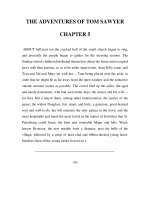MANAGING THE RISKS OF PAYMENT SYSTEMS CHAPTER 5 doc
Bạn đang xem bản rút gọn của tài liệu. Xem và tải ngay bản đầy đủ của tài liệu tại đây (197.48 KB, 37 trang )
103
5
Wire Transfers: Completing the
Transfer and Rules for Errors
A funds transfer is completed at the last link in the funds-
transfer chain when the beneficiary’s bank accepts the
payment order for the benefit of the beneficiary.
Completion of the transfer results in the discharge of the
underlying debt of the originator to the beneficiary and
the obligation of the beneficiary’s bank to pay the bene-
ficiary. This chapter discusses these subjects and con-
cludes with the Rules for Errors for all links in the
funds-transfer chain.
LAST LINK IN THE FUNDS-TRANSFER CHAIN
As noted early in Chapter 4, a funds transfer is a series of pay-
ment orders, each of which can be viewed as a link in the chain
that constitutes the transfer. The last, but not the least important,
link in the funds-transfer chain is the payment order to the ben-
eficiary’s bank. The order may be sent to the beneficiary’s bank
by the originator’s bank or may be sent by an intermediary bank.
BENEFICIARY AND THE BENEFICIARY’S BANK
Like any other receiving bank, the beneficiary’s bank has no obli-
gation to accept a sending bank’s payment order.
1
In other respects, however, the beneficiary’s bank is in a very
different position than other banks in the funds-transfer chain.
The beneficiary’s bank is the last bank in the chain, so it cannot
“execute” a payment order by sending its own payment order to
another bank. Instead, the beneficiary’s bank may reject
or “accept” the payment order for credit to the account of the
beneficiary.
Payment of the Beneficiary and Discharge of the
Underlying Obligation between the Originating
Company and the Beneficiary
Acceptance by the beneficiary’s bank is a very important event
because it determines when the beneficiary is entitled to pay-
ment by the beneficiary’s bank and when the originator’s debt to
the beneficiary is discharged.
Acceptance by the Beneficiary’s Bank. The acceptance of a pay-
ment order by the beneficiary is an interbank event because it is
another bank’s payment order that the beneficiary’s bank
receives and accepts. That acceptance, however, entitles the ben-
eficiary to be paid.
Acceptance of a Funds-Transfer Order by the Beneficiary: What Can
Go Wrong Now? There are four ways in which the beneficiary’s
bank may accept the order:
1. Payment to the beneficiary. The beneficiary’s bank may
accept the payment order of the sending bank by “pay-
ing” the beneficiary.
2
The mere credit to the beneficiary’s
account by the beneficiary’s bank does not constitute payment.
Payment typically occurs when the bank notifies the ben-
104
Wire Transfers
eficiary that the beneficiary may withdraw the amount of
the credit.
3
However, payment may also occur when the
bank applies the credit to satisfy a debt of the beneficiary
or when the funds with the payment order are “otherwise
made available” to the beneficiary.
4
An example of the
bank otherwise making the funds available is a disburse-
ment of the funds in the form of a “loan” that will be
automatically repaid when the beneficiary’s bank is paid
the amount of the order by the sending bank.
5
When is the payment final to the beneficiary? When pay-
ment has been made to the beneficiary with respect to an
obligation incurred by the bank under U.C.C. § 4A-
404(a), the payment cannot be recovered by the benefi-
ciary’s bank unless subsection (d) or (e) applies.
The exceptions to the finality principle under §4A-
405(d) and (e) relate to funds-transfer systems. First, a
funds-transfer system rule may provide that a payment to
the beneficiary is provisional until receipt of payment by
the beneficiary’s bank of the payment order it had
accepted. If the beneficiary’s bank does not receive the
payment, the rule is enforceable, provided it requires
that the originator and the beneficiary be given notice of
the rule and agree to be bound by it.
6
Second, if the funds-transfer system nets obligations
multilaterally and has a loss-sharing agreement among its
participants to provide funds when one or more partici-
pants do not meet their settlement obligations, the
acceptance of the beneficiary’s bank may be nullified if
the beneficiary’s bank accepts a payment order and the
system fails to complete settlement under the system’s
rules. Under these circumstances, the beneficiary’s bank
is entitled to recover its payment to the beneficiary.
7
In the absence of these two exceptions, payment is
final under § 4A-405.
2. Notification of the beneficiary. Acceptance of the payment
order also occurs when the bank notifies the beneficiary
105
Beneficiary and the Beneficiary’s Bank
that it has received the order or that the account has
been credited in the amount of the order, unless the
notice states that the bank is rejecting the order or that
the funds may not be withdrawn or used until the bank
receives payment for the order by the sender.
8
The
Official Comments explain how notice can constitute
acceptance:
The beneficiary’s bank may also accept by notifying
the beneficiary that the order has been received.
“Notifies” is defined in Section 1-201(26).
9
In some
cases a beneficiary’s bank will receive a payment
order during the day but settlement of the sender’s
obligation to pay the order will not occur until the
end of the day. If the beneficiary’s bank wants to
defer incurring liability to the beneficiary until the
beneficiary’s bank receives payment, it can do so.
The beneficiary’s bank incurs no liability with
respect to a payment order that it receives until it
accepts the order.
10
However, the bank may accept the order before the ben-
eficiary’s bank has been paid by the sender by giving
notice to the beneficiary of the receipt of the order or by
making a withdrawable credit of the amount of the order
to the beneficiary’s account.
3. Passive acceptance by payment by the sending bank. The bene-
ficiary’s bank may accept the payment order by waiting
until the bank receives the sender’s payment for the
order.
11
Payment and settlement among the bank partic-
ipants in a funds transfer is discussed in Chapter 4. The
Official Comments explain:
If the sender is a bank and the beneficiary’s bank
receives payment from the sender through the
Federal Reserve System or a funds transfer system
(Section 4A-403(a)(1)) or, less commonly, through
credit to an account of the beneficiary’s bank with
106
Wire Transfers
the sender or another bank (Section 4A-403(a)(2)),
acceptance by the beneficiary’s bank occurs at the
time payment is made. . . . Section 4A-209(b)(2)
results in automatic acceptance of payment orders
issued to a beneficiary’s bank by means of Fedwire
because the Federal Reserve account of the benefi-
ciary’s bank is credited and final payment is made to
that bank when the payment order is received.
12
Acceptance can occur as a result of the sender’s pay-
ment of its obligation to pay if the beneficiary’s bank pays
the wrong person by mistake. The result would be unfortu-
nate for the bank. For example, assume that the benefi-
ciary’s bank is supposed to pay John Doe but instead pays
Richard Roe. No acceptance occurs when the bank pays
Richard Roe, of course, because John Doe has not been
paid or notified that the funds are available. However, when
the sender pays the beneficiary’s bank, passive acceptance
occurs by the receipt of the payment. Because the bank has
accepted the order, it is liable to pay John Doe. The bank
may seek recovery of the funds from Richard Roe under the
law governing mistake and restitution.
13
4. Passive acceptance by ability to debit sender. If the sender has
an account with the beneficiary’s bank, the beneficiary’s
bank can debit the sender’s account to satisfy the
sender’s obligation to pay its order to the beneficiary’s
account, provided that the amount of the sender’s order
is fully covered. However, transfers may be coming into
and going out of the account during the day, and some
transfers into the account may not occur until late in the
day or after the close of the banking day. As a result, the
beneficiary’s bank may not be able to determine until the
end of the day on the payment date (the date on which
the beneficiary is to be paid
14
) whether the amount of
the sender’s order is fully covered.
Under these circumstances, acceptance can occur
on the opening of the next funds-transfer business day
107
Beneficiary and the Beneficiary’s Bank
following the payment date if, at that time, the amount
of the payment order is fully covered by a withdrawable
credit balance in an authorized account of the sender
(or if the beneficiary’s bank has otherwise been fully paid
by the sender). However, the beneficiary’s bank may pre-
vent such acceptance by a timely rejection of the pay-
ment order. The beneficiary’s bank may reject the order:
• Before the opening of the funds-transfer business day
of the bank following the payment date,
• Within one hour after the opening of the day
described in the first deadline, or
• Within one hour after the opening of the next business
day of the sender following the payment date if that time
is later than the time in the second deadline.
The last deadline permits a bank to give notice of
rejection of a payment order when the sender is in an
earlier time zone. The notice is given within one hour of
the opening of business of the sender. The Official
Comments give an example of how the deadline works:
For example, the sender may be located in
California and the beneficiary’s bank in New York.
Since in most cases notice of rejection would be
communicated electronically or by telephone, it
might not be feasible for the bank to give notice
before one hour after the opening of the funds
transfer business day in New York because at that
hour, the sender’s business day may not have started
in California. For that reason, there are alternative
deadlines stated in [§ 4A-209(b)(3)]. In the case
stated, the bank acts in time if it gives notice within
one hour after the opening of the business day of
the sender.
15
However, when the notice of rejection is received by
the sender after the payment date and the sender’s
108
Wire Transfers
account does not bear interest, the beneficiary’s bank
incurs an interest obligation to the sender.
16
In that case the bank had the use of funds of the
sender that the sender could reasonably assume
would be used to pay the beneficiary. The rate of
interest is stated in Section 4A-506. If the sender
receives notice on the day after the payment date, the
sender is entitled to one day’s interest. If receipt of
notice is delayed for more than one day, the sender is
entitled to interest for each additional day of delay.
17
Cancellation and Amendment of Payment Orders. The cancellation
and amendment of payment orders issued to banks that are not
the beneficiary’s bank are discussed in Chapter 4. After a pay-
ment order has been accepted by a bank, the general rule is that
the order can be canceled or amended only with the agreement
of the bank. That rule applies to orders accepted by the benefi-
ciary’s bank as well.
Article 4A is more restrictive, however, with respect to pay-
ment orders issued to the beneficiary’s bank. Acceptance deter-
mines when the originator’s obligation to the beneficiary is
discharged, and the drafters of Article 4A thought that it would
be inappropriate to allow the beneficiary’s bank to agree to a
cancellation or amendment except in unusual cases.
18
Thus,
even with the agreement of the bank, after the order is accepted,
cancellation or amendment of the order may occur only if the
order was issued:
(i) in execution of an unauthorized payment order or
(ii) because of a mistake by a sender in the funds transfer
which resulted in the issuance of an order that
(a) is a duplicate of an order previously issued,
(b) orders payment to a beneficiary not entitled to pay-
ment, or
(c) orders payment in an amount greater than the
amount that the beneficiary is entitled to receive.
19
109
Beneficiary and the Beneficiary’s Bank
The Official Comments illustrate postacceptance cancella-
tion or amendment of payment orders issued to the beneficiary’s
bank:
Case 1. Originator’s Bank executed a payment order
issued in the name of its customer as sender. The order
was not authorized by the customer and was fraudulently
issued. Beneficiary’s Bank accepted the payment order
issued by Originator’s Bank. Under [§ 4A-211(c)(2)]
Originator’s Bank can cancel the order if Beneficiary’s
Bank consents. It doesn’t make any difference whether
the payment order that Originator’s Bank accepted was
or was not enforceable against the customer under
Section 4A-202(b). Verification under that provision is
important in determining whether Originator’s Bank or
the customer has the risk of loss, but it has no relevance
under Section 4A-211(c)(2). Whether or not verified, the
payment order was not authorized by the customer.
Cancellation of the payment order to Beneficiary’s Bank
causes the acceptance of Beneficiary’s Bank to be nulli-
fied. [§ 4A-211(e).] Beneficiary’s Bank is entitled to
recover payment from the beneficiary to the extent
allowed by the law of mistake and restitution. In this kind
of case the beneficiary is usually a party to the fraud who
has no right to receive or retain payment of the order.
Case 2. Originator owed Beneficiary $1,000,000 and
ordered Bank A to pay that amount to the account of
Beneficiary in Bank B. Bank A issued a complying order
to Bank B, but by mistake issued a duplicate order as well.
Bank B accepted both orders. Under [§ 4A-211(c)(2)]
cancellation of the duplicate order could be made by
Bank A with the consent of Bank B. Beneficiary has no
right to receive or retain payment of the duplicate pay-
ment order if only $1,000,000 was owed by Originator to
Beneficiary.
110
Wire Transfers
Case 3. Originator owed $1,000,000 to X. Intending to pay
X, Originator ordered Bank A to pay $1,000,000 to Y’s
account in Bank B. Bank A issued a complying payment
order to Bank B which Bank B accepted by releasing the
$1,000,000 to Y. Under [§ 4A-211(c)(ii)] Bank A can can-
cel its order to Bank B with the consent of Bank B if Y was
not entitled to receive payment from the Originator.
Originator can also cancel its order to Bank A with Bank
A’s consent. [§ 4A-211(c)(1).]
Case 4. Originator owed Beneficiary $10,000. By mistake
Originator ordered Bank A to pay $1,000,000 to the
account of Beneficiary in Bank B. Bank A issued a com-
plying order to Bank B which accepted by notifying
Beneficiary of its right to withdraw $1,000,000.
Cancellation is permitted in this case under [§ 4A-
211(c)(2)(iii)]. If Bank B paid Beneficiary, it is entitled to
recover the payment except to the extent the law of mis-
take and restitution allows Beneficiary to retain $10,000,
the amount of the debt owed to Beneficiary.
20
Obligation of the Bank to Pay the Beneficiary. When the benefi-
ciary’s bank accepts a payment order, the bank becomes obli-
gated to pay the beneficiary the amount of the order.
21
Payment
is due on the payment date of the order, the day when the order
is payable to the beneficiary,
22
unless the acceptance is after the
close of the funds-transfer business day, in which case payment is
due on the next funds-transfer business day.
23
The obligation of the beneficiary’s bank to pay the benefici-
ary after accepting the payment order was thought by the Article
4A drafters to be a very serious obligation. Thus, if the bank fails
to pay and is notified of the particular circumstances that might
give rise to the beneficiary’s sustaining consequential damages,
the beneficiary can recover the consequential damages unless
the bank can prove that it had a reasonable doubt concerning
the right of the beneficiary to payment.
24
Moreover, the
111
Beneficiary and the Beneficiary’s Bank
obligation of the beneficiary’s bank to pay the beneficiary cannot
be disclaimed by the bank in an agreement between the bank
and the beneficiary.
25
The Official Comments discuss the beneficiary’s right to
recover consequential damages:
[Section 4A-404(a)] provides that the beneficiary of an
accepted payment order may recover consequential dam-
ages if the beneficiary’s bank refuses to pay the order
after demand by the beneficiary if the bank at that time
had notice of the particular circumstances giving rise to
the damages. Such damages are recoverable only to the
extent that the bank had “notice of the damages.” The
quoted phrase requires that the bank have notice of the
general type or nature of the damages that will be suf-
fered as a result of the refusal to pay and their general
magnitude. There is no requirement that the bank have
notice of the exact or even the approximate amount of
the damages, but if the amount of damages is extraordi-
nary the bank is entitled to notice of that fact. For exam-
ple, in Evra Corp. v. Swiss Bank Corp.,
26
failure to complete
a funds transfer of only $27,000 required to retain rights
to a very favorable ship charter resulted in a claim for
more than $2,000,000 of consequential damages. Since it
is not reasonably foreseeable that a failure to make a rel-
atively small payment will result in damages of this mag-
nitude, notice is not sufficient if the beneficiary’s bank
has notice only that the $27,000 is necessary to retain
rights on a ship charter. The bank is entitled to notice
that an exceptional amount of damages will result as well.
For example, there would be adequate notice if the bank
had been made aware that damages of $1,000,000 or
more might result.
27
Consequential damages are not available when the refusal of
the beneficiary’s bank to pay the beneficiary is based on “a rea-
112
Wire Transfers
TEAMFLY
Team-Fly
®
sonable doubt concerning the right of the beneficiary to pay-
ment.” The Official Comments explain that the “reasonable
doubt” exception to the obligation of the beneficiary’s bank to
pay the beneficiary does not apply to a dispute between the orig-
inator and the beneficiary:
For example, the originator may try to prevent payment
to the beneficiary by the beneficiary’s bank by alleging
that the beneficiary is not entitled to payment because of
fraud against the originator or a breach of contract relat-
ing to the obligation. The fraud or breach of contract
claim of the originator may be grounds for recovery by
the originator from the beneficiary after the beneficiary
is paid, but it does not affect the obligation of the benefi-
ciary’s bank to pay the beneficiary. Unless the payment
order has been cancelled pursuant to Section 4A-211(c),
there is no excuse for refusing to pay the beneficiary and,
in a proper case, the refusal may result in consequential
damages. Except in the case of a book transfer, in which
the beneficiary’s bank is also the originator’s bank, the
originator of a funds transfer cannot cancel a payment
order to the beneficiary’s bank, with or without the con-
sent of the beneficiary’s bank, because the originator is
not the sender of that order. Thus, the beneficiary’s bank
may safely ignore any instruction by the originator to
withhold payment to the beneficiary.
28
If the payment order instructs payment to a particular
account of the beneficiary, the bank must notify the beneficiary
of its receipt of the order before midnight of the next funds-
transfer business day following the payment date. If the order
does not instruct payment to an account of the beneficiary, the
notice is required only if the payment order requires it. If the
bank fails to give the required notice, the bank must pay interest
from the day notice should have been given until the day the
beneficiary learns of the bank’s receipt of the payment order. No
113
Beneficiary and the Beneficiary’s Bank
other damages are recoverable, but if the beneficiary must sue to
compel the bank to pay the interest, the beneficiary may recover
its reasonable attorney’s fees.
29
The Official Comments observe that if acceptance occurs
under the provisions that involve the beneficiary’s bank giving
notice of receipt of the order to the beneficiary, as it often does,
the notice would be given in any event. The obligation to give
notice thus will be meaningful only when acceptance occurs under
other provisions, such as when the acceptance occurs because the
beneficiary’s bank receives payment for the payment order.
30
Payment to Beneficiary and Discharge of Debt of Originator. Funds
transfers normally serve the purpose of discharging an obliga-
tion, such as to pay for goods or services, to pay the purchase
price in an acquisition, or to repay an indebtedness. It was noted
earlier that when the beneficiary’s bank accepts a payment order,
the beneficiary becomes obligated to pay the beneficiary’s bank.
The payment is not due until the payment date, but the obliga-
tion is incurred upon the bank’s acceptance of the payment
order.
31
At the same time, the obligation of the originator to the
beneficiary is discharged.
32
Thus, the obligation of the originator
to pay the beneficiary is replaced by the obligation of the bene-
ficiary’s bank.
Section 4A-406(a) states the “fundamental rule”
33
that the
originator’s payment to the beneficiary in a funds transfer occurs
when the beneficiary’s bank accepts the payment order for the
beneficiary. Section 4A-406(b) states that if the payment was
made to satisfy an obligation of the originator, the obligation is
discharged “to the same extent discharge would result from pay-
ment to the beneficiary of the same amount in money.”
Discharge does not occur, however, when:
• The payment was by a means prohibited by a contract with
the beneficiary,
• The beneficiary within a reasonable time after receiving
notice of the receipt of the payment order by the bank
114
Wire Transfers
notified the originator that the beneficiary refused the
payment,
• The funds received by the beneficiary’s bank were not
withdrawn by the beneficiary or applied to a debt of the
beneficiary, and
• The beneficiary would suffer a loss that could reasonably
have been avoided if the payment had been by a means
that complied with the contract.
The mere fact that the originator breached a contract obli-
gation by paying via a funds transfer rather than by other means
does not mean that the beneficiary has sustained any loss. The
law discharges the debt of the originator despite the breach
unless the breach has caused a loss to the beneficiary and all of
the other conditions specified above are satisfied.
When the originator’s breach has caused a loss to the benefi-
ciary, the purpose of the exception to the rule that the bank’s
acceptance discharges the originator’s obligation is to allocate
the risk of the insolvency of the beneficiary’s bank. The Official
Comments explain the discharge rules:
In a large percentage of funds transfers, the transfer is
made to pay an obligation of the originator. [Section 4A-
406(a)] states that the beneficiary is paid by the originator
when the beneficiary’s bank accepts a payment order for
the benefit of the beneficiary. When that happens, the
effect under [§ 4A-406(b)] is to substitute the obligation of
the beneficiary’s bank for the obligation of the originator.
The effect is similar to that under Article 3 if a cashier’s
check payable to the beneficiary had been taken by the
beneficiary. Normally, payment by funds transfer is sought
by the beneficiary because it puts money into the hands of
the beneficiary more quickly. As a practical matter the ben-
eficiary and the originator nearly always agree to the funds
transfer in advance. Under [§ 4A-406(b)] acceptance
by the beneficiary’s bank will result in discharge of the
115
Beneficiary and the Beneficiary’s Bank
obligation for which payment was made unless the benefi-
ciary has made a contract with respect to the obligation
which did not permit payment by the means used. Thus, if
there is no contract of the beneficiary with respect to the
means of payment of the obligation, acceptance by the
beneficiary’s bank of a payment order to the account of the
beneficiary can result in discharge.
34
The Official Comments give examples of the exception to
the rule that acceptance by the beneficiary’s bank results in the
discharge of the originator’s obligation to the beneficiary:
Suppose Beneficiary’s contract stated that payment of an
obligation owed by Originator was to be made by a
cashier’s check of Bank A. Instead, Originator paid by a
funds transfer to Beneficiary’s account in Bank B. Bank B
accepted a payment order for the benefit of Beneficiary
by immediately notifying Beneficiary that the funds were
available for withdrawal. Before Beneficiary had a reason-
able opportunity to withdraw the funds, Bank B sus-
pended payments [i.e., filed for relief in insolvency
proceedings]. Under the unless clause of [§ 4A-406(b)]
Beneficiary is not required to accept the payment as dis-
charging the obligation owed by Originator to
Beneficiary if Beneficiary’s contract means that
Beneficiary was not required to accept payment by wire
transfer. Beneficiary could refuse the funds transfer as
payment of the obligation and could resort to rights
under the underlying contract to enforce the obligation.
The rationale is that Originator cannot impose the risk of
Bank B’s insolvency on Beneficiary if Beneficiary had
specified another means of payment that did not entail
that risk. If Beneficiary is required to accept Originator’s
payment, Beneficiary would suffer a loss that would not
have occurred if payment had been made by a cashier’s
116
Wire Transfers
check on Bank A, and Bank A had not suspended pay-
ments. In this case Originator will have to pay twice. It is
obliged to pay the amount of its payment order to the
bank that accepted it and has to pay the obligation it owes
to the Beneficiary which has not been discharged.
35
The Originator would have the right, however, to seek recov-
ery from Bank B.
36
The Official Comments give another example
of the application of the exception to the discharge rule in which
the exception does not apply and the obligation is thereby
discharged:
Suppose Beneficiary’s contract called for payment by a
Fedwire transfer to Bank B, but the payment order
accepted by Bank B was not a Fedwire transfer. Before the
funds were withdrawn by Beneficiary, Bank B suspended
payments. The sender of the payment order to Bank B
paid the amount of the order to Bank B. In this case the
payment by Originator did not comply with Beneficiary’s
contract, but the noncompliance did not result in a loss
to Beneficiary as required by [§ 4A-406(b)(iv)]. A
Fedwire transfer avoids the risk of the insolvency of the
sender of the payment order to Bank B, but it does not
affect the risk that Bank B will suspend payments before
withdrawal of the funds by Beneficiary. Thus, the unless
clause of [§ 4A-406(b)] is not applicable and the obliga-
tion owed to Beneficiary is discharged.
As noted earlier, the discharge would occur despite the
deduction by a bank of its charges in the funds-transfer transac-
tion. If an intermediary bank charges $10 in the transaction, for
example, and the beneficiary receives $999,990 in satisfaction of
indebtedness of $1,000,000, the debt is nevertheless discharged
unless the beneficiary demands payment of, and the originator
fails to pay, the $10 charge.
37
117
Beneficiary and the Beneficiary’s Bank
Interest Compensation. A receiving bank is required to pay inter-
est to the sender when:
• The bank is liable to the customer for a fraudulent trans-
fer that was duly reported by the customer,
38
• The sender receives notice of the rejection of a payment
order by the beneficiary’s bank after the payment date of
the order,
39
• The bank fails to execute a payment order without giving
a notice of rejection and the sender’s account has suffi-
cient funds to cover the order,
40
• Improper execution by the bank results in the delay of pay-
ment to the beneficiary,
41
•The receiving bank is obliged to refund the sender’s pay-
ment under the “money-back guarantee,”
42
or
• The beneficiary’s bank fails to give the required notice to
the beneficiary of the bank’s receipt of the payment
order.
43
The receiving bank and the sender in the funds-transfer
transaction may agree on the terms of interest payable by the
bank to the sender. Such terms may also be established by a
funds-transfer system rule. In the absence of an agreement or
funds-transfer system rule, the terms of the interest compensa-
tion payable by a receiving bank to a sender are governed by
§ 4A-506.
44
The rate of interest is the average of the Federal Funds Rates
published by the Federal Reserve Bank of New York for each of
the days for which interest is payable divided by 360 (360 days
basis). The amount of interest is determined by multiplying the
rate by the amount on which interest is payable and multiplying
the product by the number of days for which interest is payable.
If on any of those days a published rate is not available, the rate
for that day is the same as the published rate for the next pre-
ceding day for which a rate is available.
45
If the interest is payable
because the transfer was not completed but the failure to com-
plete the transfer was not due to the fault of the bank, the inter-
118
Wire Transfers
est is reduced by the percentage equal to the reserve require-
ment on deposits of the bank.
46
The Official Comments provide the following example:
A bank is obliged to pay interest on $1,000,000 for three
days, July 3, July 4, and July 5. The published Fed Funds
rate is .082 for July 3 and .081 for July 5. There is no pub-
lished rate for July 4 because that is not a banking day.
The rate for July 3 applies to July 4. The applicable
Federal Funds rate is .08167 (the average of .082, .082,
and .081) divided by 360 which equals .0002268. The
amount of interest payable is $1,000,000 × .0002268 × 3 =
$680.40.
47
Set-Off, Priority, and Litigation. Suppose that the beneficiary owes
its bank $1,000 and the bank receives a $1,000 payment order for
the beneficiary. May the bank apply the funds to set off the debt of
its beneficiary? Yes; § 4A-502(c) states that after the bank credits
the beneficiary’s account, the amount credited “may be set off
against an obligation owed by the beneficiary by the bank.”
Suppose that the customer’s bank receives a payment order
from the customer at 10:00
A.M. to pay Company X $1,000, an
order from the customer at 10:05
A.M. to pay Company Y $1,500,
and another from the customer at 10:30
A.M. to pay Company Z
$2,000. At 10:35 the bank decides to act on the three orders, but
there is only $2,000 in the account. May the bank execute the
order for $2,000 even though it was the last order it received? Yes;
the bank may execute the customer’s orders in any sequence.
48
Suppose that a bank finds itself in litigation with another
party to the funds transfer. What law applies in the litigation?
The parties may by agreement choose the applicable law.
49
If
they do not do so:
• The rights and obligations between a sender and a receiv-
ing bank are governed by the law of the jurisdiction in
which the receiving bank is located,
119
Beneficiary and the Beneficiary’s Bank
• The rights and obligations between the beneficiary’s bank
and the beneficiary are governed by the law of the juris-
diction in which the beneficiary’s bank is located, and
•The issue of when payment is made by the originator to
the beneficiary is governed by the law of the jurisdiction in
which the beneficiary’s bank is located.
50
Suppose that the customer is squabbling with its creditors.
The bank receives a payment order instructing the bank to pay
Creditor X. The bank executes the order in reliance on there
being sufficient withdrawable funds in the customer’s account to
cover the order. Before the bank debits the customer’s account,
however, the bank is served with creditor process by Creditor Y
attaching the funds in the account. If the attachment is valid and
the bank must pay Creditor Y, there will be insufficient funds to
cover the payment order issued to pay Creditor X. Under these
circumstances the bank is allowed to debit the customer’s
account to pay for the order it issued despite the process served
by Creditor Y.
51
MANAGING RISKS IN THE LINKS OF THE
WIRE TRANSFER PAYMENT SYSTEM
Beneficiary and the Beneficiary’s Bank
The beneficiary and the originator both expect that the benefi-
ciary will receive the amount of a wire transfer from the benefi-
ciary’s bank.
This section discusses the legal solutions to the complicated
situations than can arise when the funds have been transferred
but the beneficiary has not received the funds. Once the bank has
accepted the final payment order, the last link in the funds-transfer
chain, the beneficiary is entitled to payment. If the bank has cred-
ited the funds to the wrong account, the beneficiary is entitled
to be paid by the bank. If the bank has exercised any set-off rights
against the transferred funds, then the beneficiary will be
120
Wire Transfers
deemed to have been paid to the extent that the bank has set off
an amount equivalent to the bank’s claim against the beneficiary.
The originator may arrange with the beneficiary that the ben-
eficiary will confirm receipt of wire transfer payments. Doing so
will help to ensure that the originator will know when the trans-
ferred funds have actually been received by the beneficiary, and if
they have not been received, the originator will know that as well.
That type of arrangement is especially appropriate when funds are
transferred in very large amounts, or are wired as part of contrac-
tual closing requirements, and in other situations in which the par-
ties agree that confirmation is appropriate. Such arrangements do
not directly involve the sending, intermediary, or receiving banks.
RULES FOR ERRORS
The general rule with respect to errors under Article 4A is that
the customer and the bank are each liable for their own errors.
The general rule is not explicitly stated as such in Article 4A, but
it may be extrapolated from all of the rules relating to the errors
of the parties in the funds-transfer chain.
52
Errors can occur at each link in the chain. The customer may
commit an error in the first payment order in the chain that orig-
inates the funds transfer. The customer’s bank may commit an
error in the payment order it issues in execution of the order. An
intermediary bank may commit an error when it executes the
payment order it receives, and the beneficiary’s bank may com-
mit an error when it accepts the final payment order in the
funds-transfer chain.
This section examines the rules applicable to the errors that
may be committed in the course of a funds transfer by the vari-
ous parties to the transfer, beginning with the customer’s errors.
General Rule for Customer Errors
The general rule is that the Customer is liable for its own errors
contained in any payment order issued to the customer’s bank.
121
Rules for Errors
The general rule is not explicitly stated in Article 4A but is
implicit in § 4A-302(a)(1).
A receiving bank has no obligation to execute a payment
order it has received.
53
If the bank nevertheless accepts the
order, however, § 4A-302(a) states that the bank is obliged to
issue “a payment order complying with the sender’s order” and
also obliged to follow the sender’s instructions concerning:
• Any intermediary bank or funds-transfer system to be used
in carrying out the funds transfer, or
• The means by which payment orders are to be transmitted
in the funds transfer.
Moreover, the originator’s bank is obliged to instruct the
intermediary bank according to the instruction of the originator.
Stated otherwise, if the payment order of the customer con-
tains an error, the bank is obliged to perpetuate the error
because the bank is obliged to comply with the customer’s
instructions. On this basis, the bank cannot be held liable for the
customer’s errors.
Special rules apply, however, to errors designated by Article
4A as “misdescription” errors and when the bank and the cus-
tomer have agreed that the bank will use a security procedure to
detect the customer’s errors. These rules are discussed in the fol-
lowing paragraphs.
Misdescription Errors
Probably the most common form of customer error is a misde-
scription error. A misdescription occurs when the customer
identifies the beneficiary or a bank in the funds-transfer trans-
action by both a name and a number, and the name and num-
ber identify different persons, that is, either the name or the
number is erroneous. Liability for losses resulting from the mis-
description of the beneficiary is covered by § 4A-207, and liabil-
ity for losses resulting from the misdescription of a bank is
covered by § 4A-208.
122
Wire Transfers
TEAMFLY
Team-Fly
®
Misdescription of the Beneficiary. In a typical case involving the
misdescription of the beneficiary, the customer’s payment order
to its bank identifies the beneficiary by a name and a number.
The name and number refer to different persons. The name is
correct, but the number identifies the wrong person. When the
payment order reaches the beneficiary’s bank, the bank ignores
the name and processes the payment order on the basis of the
number. As a result, the funds are credited to the wrong person.
If the funds cannot be recovered from that person, who is liable
for the loss: the customer or the beneficiary’s bank?
General Rule for Beneficiary Misdescription. The general rule for
beneficiary misdescription imposes liability on the customer.
The beneficiary’s bank is allowed to rely on the number and
ignore the name. Section 4A-207 provides that if a payment
order received by the beneficiary’s bank “identifies the benefici-
ary both by name and by an identifying or bank account number
and the name and number identify different persons,” the bene-
ficiary’s bank “may rely on the number as the proper identifica-
tion of the beneficiary of the order.”
54
Moreover, the bank has no
duty to determine whether the name and number refer to the
same person.
55
The reason for the rule is that banks normally process pay-
ment orders by automated means that identify the beneficiary by
number and are not capable of identifying the beneficiary by
name. The Article 4A drafters, consistent with their goal of main-
taining the high-speed, low-cost features of funds transfers,
wanted to facilitate the continued use of automated means. The
Official Comments explain the rule:
A very large percentage of payment orders issued to the
beneficiary’s bank by another bank are processed by auto-
mated means using machines capable of reading orders
on standard formats that identify the beneficiary by an
identifying number or the number of a bank account.
The processing of the order by the beneficiary’s bank and
123
Rules for Errors
the crediting of the beneficiary’s account are done by use
of the identifying or bank account number without
human reading of the payment order itself. The process
is comparable to that used in automated payment of
checks. The standard format, however, may also allow the
inclusion of the name of the beneficiary and other infor-
mation which can be useful to the beneficiary’s bank and
the beneficiary but which plays no part in the process of
payment. If the beneficiary’s bank has both the account
number and name of the beneficiary supplied by the orig-
inator of the funds transfer, it is possible for the benefi-
ciary’s bank to determine whether the name and number
refer to the same person, but if a duty to make that deter-
mination is imposed on the beneficiary’s bank the bene-
fits of automated payment are lost. Manual handling of
payment orders is both expensive and subject to human
error. If payment orders can be handled on an automated
basis there are substantial economies of operation and
the possibility of clerical error is reduced.
56
Exceptions to the General Rule. There are two exceptions to the
general rule:
1. The customer’s bank is liable for the loss when it has not
notified the originating customer that the beneficiary’s
bank might pay on the basis of the number (unless the
originator is also a bank), and
2. The beneficiary’s bank is liable for the loss when the bank
knows that the name and number refer to different persons.
Customer’s Bank Liable for Failure to Give Notice. Liability for a
loss resulting from a customer’s misdescription error shifts from
the customer to the customer’s bank when the customer’s bank
has failed to give the customer notice that the beneficiary’s bank
may rely on the number. To avoid the loss, the bank must prove
that the customer:
124
Wire Transfers
had notice that payment of a payment order issued by
the originator might be made by the beneficiary’s bank
on the basis of an identifying or bank account number
even if it identifies a person different from the named
beneficiary.
57
The notice need not be given, however, when the originator
is also a bank. The purpose of the rule shifting liability to the cus-
tomer’s bank is to protect customers who may not be aware that
the beneficiary’s bank might process the payment order on the
basis of the number. Banks, however, are thought not to need
such protection.
[Section 4A-207(c)] is designed to protect the originator
. . . . Under that [section], the originator is responsible
for the inconsistent description of the beneficiary if it had
notice that the order might be paid by the beneficiary’s
bank on the basis of the number. If the originator is a
bank, the originator always has that responsibility. The
rationale is that any bank should know how payment
orders are processed and paid. If the originator is not a
bank, the originator’s bank must prove that its customer,
the originator, had notice.
58
The notice may be included in a Funds Transfer Services
Agreement or provided to the customer in a separate document
or even, it appears, provided orally:
Notice can be proved by any admissible evidence, but the
bank can always provide notice by providing the customer
with a written statement of the required information and
obtaining the customer’s signature to the statement. The
statement will then apply to any payment order accepted
by the bank thereafter. The information need not be sup-
plied more than once.
59
125
Rules for Errors
The most effective way to prove that the notice has been
given is to produce the notice signed by the customer, and the
most efficient way to obtain the customer’s signature on the
notice is to insert it into the Funds Transfer Services Agreement.
Good banking practice thus dictates that every customer sign an
Agreement and every Agreement contain the notice. The notice
should state that the beneficiary’s bank might make payment on
the basis of the number “even if it identifies a person different
from the named beneficiary.”
60
Beneficiary’s Bank Liable When Aware of Discrepancy. Under the
general rule, the beneficiary’s bank, in processing a payment
order in which the beneficiary is misdescribed, may rely on the
number and ignore the name. If the bank processes the payment
order on the basis of the name and a loss results from the mis-
description, the beneficiary’s bank is liable for the loss.
61
Moreover, the general rule applies only when the “benefi-
ciary’s bank does not know that the name and number refer to
different persons.”
62
Thus, the beneficiary’s bank is liable for
losses when it has “knowledge” that the name and number refer
to different persons.
How might such knowledge be acquired by the beneficiary’s
bank? Under the general rules and definitions of the Uniform
Commercial Code, a party in a transaction is regarded as having
“knowledge” of a fact when it is brought to the attention of the
individual conducting the transaction or when the fact would
have been brought to the attention of that individual if the party
had exercised “due diligence.”
63
On this basis, the beneficiary’s bank would have “knowledge”
that the name and number refer to different persons when that
fact is brought to the attention of the individual conducting the
transaction in the bank’s wire room or when that fact should
have been brought to the attention of that individual if the ben-
eficiary’s bank had exercised due diligence. In normal circum-
stances the bank can be expected to exercise due diligence, and
thus the “knowledge” exception to the general rule that the ben-
126
Wire Transfers
eficiary’s bank may rely on the number and ignore the name,
would normally present no problem to the bank. The bank
would typically not have knowledge of the name and number dis-
crepancy, and when it had actual knowledge it would not accept
the payment order.
The capability of modern computers, however, poses uncer-
tainty in the rules. Suppose that the bank’s software is capable of
alerting the wire room personnel to the existence of a name in
the payment order. Does due diligence require the wire room
personnel to check the name against the account number to be
certain that the name and number match? Perhaps not. Article
4A makes clear that the beneficiary’s bank “need not determine
whether the name and number refer to the same person.”
64
Fraudulently Induced Misdescription. The foregoing rules may
apply to relieve the beneficiary’s bank of liability when it has
relied on the number in processing a misdescribed payment if
the misdescription has been fraudulently induced. The Official
Comments give an example of a thief fraudulently inducing an
originator to issue a payment order in which the name and num-
ber refer to different persons:
Doe is the holder of shares in Mutual Fund. Thief, imper-
sonating Doe, requests redemption of the shares and
directs Mutual Fund to wire the redemption proceeds to
Doe’s account #12345 in Beneficiary’s Bank. Mutual Funds
originates a funds transfer by issuing a payment order to
Originator’s Bank to make a payment to Doe’s account
#12345 in Beneficiary’s Bank. Originator’s Bank executes
the order by issuing a conforming order to Beneficiary’s
Bank, which makes payment to account #12345. That
account is the account of Roe rather than Doe.
65
In the foregoing example, Thief has fraudulently induced
Mutual Fund to issue a payment order in which the beneficiary
is misdescribed. The name of the beneficiary, Doe, is correct, but
127
Rules for Errors









